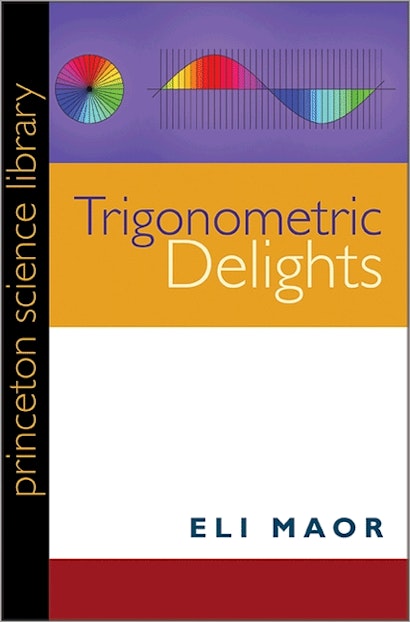Trigonometry has always been an underappreciated branch of mathematics. It has a reputation as a dry and difficult subject, a glorified form of geometry complicated by tedious computation. In this book, Eli Maor draws on his remarkable talents as a guide to the world of numbers to dispel that view. Rejecting the usual arid descriptions of sine, cosine, and their trigonometric relatives, he brings the subject to life in a compelling blend of history, biography, and mathematics. He presents both a survey of the main elements of trigonometry and a unique account of its vital contribution to science and social development. Woven together in a tapestry of entertaining stories, scientific curiosities, and educational insights, the book more than lives up to the title Trigonometric Delights.
?
Maor, whose previous books have demystified the concept of infinity and the unusual number “e,” begins by examining the “proto-trigonometry” of the Egyptian pyramid builders. He shows how Greek astronomers developed the first true trigonometry. He traces the slow emergence of modern, analytical trigonometry, recounting its colorful origins in Renaissance Europe’s quest for more accurate artillery, more precise clocks, and more pleasing musical instruments. Along the way, we see trigonometry at work in, for example, the struggle of the famous mapmaker Gerardus Mercator to represent the curved earth on a flat sheet of paper; we see how M. C. Escher used geometric progressions in his art; and we learn how the toy Spirograph uses epicycles and hypocycles.
Maor also sketches the lives of some of the intriguing figures who have shaped four thousand years of trigonometric history. We meet, for instance, the Renaissance scholar Regiomontanus, who is rumored to have been poisoned for insulting a colleague, and Maria Agnesi, an eighteenth-century Italian genius who gave up mathematics to work with the poor—but not before she investigated a special curve that, due to mistranslation, bears the unfortunate name “the witch of Agnesi.” The book is richly illustrated, including rare prints from the author’s own collection. Trigonometric Delights will change forever our view of a once dreaded subject.
Eli Maor teaches the history of mathematics at Loyola University in Chicago. He is the author of To Infinity and Beyond, e: The Story of a Number, Venus in Transit, and The Pythagorean Theorem: A 4,000-Year History.
"Maor's presentation of the historical development of the concepts and results deepens one's appreciation of them, and his discussion of the personalities involved and their politics and religions puts a human face on the subject. His exposition of mathematical arguments is thorough and remarkably easy to understand. There is a lot of material here that teachers can use to keep their students awake and interested. In short, Trigonometric Delights should be required reading for everyone who teaches trigonometry and can be highly recommended for anyone who uses it."—George H. Swift, American Mathematics Monthly
"[Maor] writes enthusiastically and engagingly. . . . Delightful reading from cover to cover. Trigonometric Delights is a welcome addition."—Sean Bradley, MAA Online
"Maor clearly has a great love of trigonometry, formulas and all, and his enthusiasm shines through. . . . If you always wanted to know where trigonometry came from, and what it's good for, you'll find plenty here to enlighten you."—Ian Stewart, New Scientist
"This book will appeal to a general audience interested in the history of mathematics. I highly recommend [it] to teachers who would like to ground their lessons in the sort of mathematical investigations that were undertaken throughout history."—Richard S. Kitchen, Mathematics Teacher
"If you think trigonometry has no more surprises for you, read Trigonometric Delights. Eli Maor will change your mind. The book presents the subject and its history the way they should be presented—it's a delight to read."—Paul J. Nahin, author of Duelling Idiots and Other Probability Puzzlers
"This book will appeal to a general audience interested in the history of mathematics. I highly recommend [it] to teachers who would like to ground their lessons in the sort of mathematical investigations that were undertaken throughout history."—Richard S. Kitchen, Mathematics Teacher
"Here is trigonometry viewed through the lens of history—a rich, intriguing book that will leave readers shouting for Maor."—William Durham, author of The Mathematical Universe.
"[Maor] writes enthusiastically and engagingly. . . . Delightful reading from cover to cover. Trigonometric Delights is a welcome addition."—Sean Bradley, Mathematical Association of America
"Maor eases the reader from the mathematical puzzles of the Rhind Papyrus all the way to infinite series and the analysis of music produced by vibrating strings. Along the course, he leads a grand tour of the lovely but often neglected area of mathematics called trigonometry."—Jerry P. King, Professor of Mathematics at Lehigh University
"This is a rich and challenging book that will appeal to mathematicians and should help attract a newer generation to the subject. By putting the history back into trigonometry, Maor tells the many stories of trigonometry, and shows that what is often regarded as a collection of dry techniques is really a marvelous testament to thousands of years of human ingenuity and intellectual creativity."—Keith Devlin, author of Mathematics: The Science of Patterns and Goodbye Descartes


